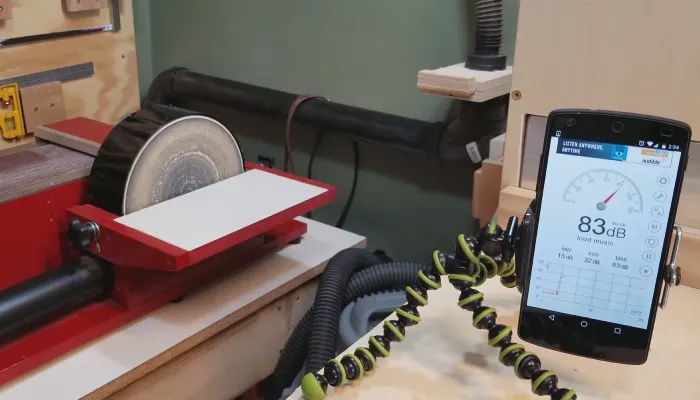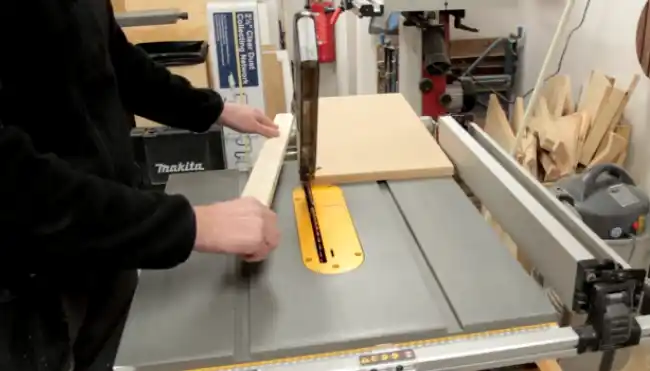Are you wondering why your table saw is making so much noise? It can be quite frustrating when the loud whirring sound interrupts your woodworking projects. But fear not, because we’ve got the answers you’re looking for! In this article, we’ll dive into the reasons behind why your table saw is so loud.
Picture this: you’re in your workshop, all set to start cutting some wood with your trusty table saw. But as soon as you flip the switch, the noise becomes deafening. It’s like a jackhammer shaking the entire room! So, what’s going on? Why is your table saw making such a racket? We’ll uncover the reasons behind this mystery and help you find a solution.
We understand that dealing with a noisy table saw can be really bothersome. Not only is it distracting, but it can also cause ear fatigue and affect your overall woodworking experience. But worry not! In this article, we’ll explore the possible causes of this noise and present some practical solutions to quieten your table saw down. Let’s get to the bottom of “why is my table saw so loud?” and ensure a smoother, more peaceful woodworking journey for you.

Why Is My Table Saw So Loud?
Introduction: If you’ve ever used a table saw, you’re probably familiar with the loud noise it produces. But have you ever wondered why your table saw is so loud? In this article, we’ll explore the reasons behind the noise and how you can reduce it to create a quieter working environment.
1. Motor Size and Power
When it comes to table saw noise, the motor size and power play a significant role. Most table saws have powerful motors that generate noise while operating. The larger the motor size and power, the louder the noise will be. This is because the larger motors produce more vibrations, which result in increased noise levels.
Additionally, the power requirements of the motor can also impact the noise level. If the table saw is underpowered, the motor may strain to perform, resulting in louder noise as it works harder to make cuts. It’s essential to choose a table saw with an appropriately-sized motor for the type of work you’ll be doing to minimize noise.
To reduce the noise caused by the motor, you can invest in a table saw with a quieter motor or consider adding additional soundproofing measures to your workshop, such as insulation or noise-absorbing materials.
2. Blade Quality and Material
The type of blade you use in your table saw can also contribute to the noise level. Blades made of lower-quality materials or with dull teeth tend to create more noise when cutting through the wood. The friction between the blade and the wood generates vibrations that translate into audible noise.
To minimize noise caused by the blade, ensure you are using a high-quality blade appropriate for the type of cut you’re making. Sharpen and maintain your blades regularly to ensure smooth and efficient cuts. Additionally, using a blade with noise-reducing features, such as vibration-dampening technology, can help reduce noise levels.
Moreover, the size and design of the blade also affect noise. Smaller blades tend to be quieter than larger ones, as they produce fewer vibrations. Consider using a smaller blade for tasks that don’t require larger cuts to reduce noise.
3. Table Saw Maintenance
The overall maintenance of your table saw can impact its noise level. Regular maintenance, such as lubricating moving parts and ensuring the blade is aligned properly, can significantly reduce noise. When parts are not properly lubricated, friction intensifies, resulting in increased noise.
Furthermore, loose or misaligned parts can also contribute to noise. Ensure all parts of your table saw are tightened and adjusted correctly to prevent unnecessary vibrations and noise. Additionally, clean off any sawdust or debris from the saw, as buildup can affect the saw’s performance and noise level.
Regular maintenance and attention to detail can go a long way in reducing the noise produced by your table saw and increasing its overall efficiency.
Additional Information
4. Material Being Cut
The type of material being cut can also impact the noise level of your table saw. Hardwoods, for example, can produce more noise than softwoods due to their density. Keep this in mind when working with different types of wood to anticipate potential variations in noise levels.
5. Blade Guard and Accessories
The blade guard and accessories attached to your table saw can affect its noise level. Improperly installed or damaged blade guards can lead to excessive vibrations and noise. Make sure all accessories are securely attached to minimize noise and maintain safety.
6. Workstation Setup
The setup of your workstation can also contribute to the noise levels of your table saw. Ensure you have a sturdy and stable table or workbench for the saw to reduce vibrations. Additionally, consider positioning your table saw away from walls or hard surfaces that can reflect and amplify noise.
Noise Reduction Tips
7. Use Soundproofing Measures
Consider adding soundproofing measures to your workshop to reduce the noise generated by your table saw. This can include installing sound-absorbing panels, using noise-canceling curtains, or adding insulation to the walls and ceiling.
8. Wear Hearing Protection
Protecting your ears is crucial when working with a loud table saw. Invest in high-quality hearing protection, such as earmuffs or earplugs, to minimize the impact of the noise on your hearing.
9. Choose Quieter Operating Times
If possible, plan your woodworking projects during quieter hours to minimize disturbances to yourself and others. Early mornings or late evenings when neighbors are less likely to be affected by noise can be ideal times to use your table saw.
In summary, understanding the reasons behind the noise produced by your table saw and implementing measures to reduce it can lead to a more pleasant and comfortable woodworking experience. Whether it’s through choosing the right motor size, using high-quality blades, or practicing regular maintenance, minimizing table saw noise can create a quieter and more enjoyable working environment.
Key Takeaways: Why is My Table Saw So Loud?
- Table saws can be loud because of the motor, blade design, or loose parts.
- The motor is often the main source of noise in a table saw.
- Blade design, such as tooth count and gullet shape, can also contribute to noise.
- Loose parts, like belts or pulleys, can create rattling or squeaking sounds.
- Regular maintenance, like lubricating moving parts, can help reduce table saw noise.
Frequently Asked Questions
Table saws can be quite noisy, which can be bothersome for users. If you’re wondering why your table saw is making so much noise, check out these common questions and answers to help you understand the reasons behind the loudness.
Why is my table saw emitting a loud noise when I use it?
There are a few potential reasons for your table saw to be loud during operation. One reason could be improper maintenance. Over time, the motor, belts, gears, and other components can wear down, causing increased noise levels. Another possible culprit could be a misalignment of the blade or other parts, creating friction and resulting in a louder operation. Lastly, the type of material being cut can also affect the noise level; cutting denser or harder woods may produce louder noises than softer ones.
If you’re experiencing a significant increase in noise or the noise is accompanied by unusual vibrations or other issues, it’s best to consult the manufacturer’s manual or a professional to diagnose and address the problem to ensure safe and efficient operation.
How can I reduce the noise produced by my table saw?
If you’re looking to reduce the noise produced by your table saw, there are a few steps you can take. First, make sure the saw is positioned on a stable and level surface. A wobbly or uneven base can amplify vibrations and noise. Additionally, using a quality extension cord with sufficient gauge can help improve power delivery and reduce electrical noise.
Furthermore, regular maintenance can make a difference. Lubricating moving parts, tightening loose screws, and replacing worn-out components can help minimize noise levels. Investing in a higher-quality blade designed for precision, such as a carbide-tipped blade, can also contribute to a quieter operation.
Does the type of blade affect the noise level of a table saw?
Yes, the type of blade you use can impact the noise level of your table saw. Blades made with different materials and designs can produce varying levels of noise. For example, blades with larger teeth or deeper gullets tend to create more noise as they cut through the wood. Additionally, blades made from lower-quality materials may vibrate more, resulting in increased noise levels.
To reduce noise, consider using blades specifically designed for quieter operation. Look for blades with special noise-reducing features or those made from materials that minimize vibrations. A high-quality, well-maintained blade will not only contribute to a quieter cutting experience but also deliver cleaner cuts.
Is it normal for a table saw to be loud?
While table saws do tend to generate noise due to their powerful motors and cutting action, excessive or unusual noise may indicate an underlying issue. A table saw operating within normal parameters should produce a consistent and relatively moderate level of noise. If you notice a sudden increase in noise or any abnormal sounds, it’s worth investigating to ensure there are no mechanical problems that could affect the saw’s performance or safety.
To determine if the noise level is within an acceptable range, compare it to the manufacturer’s specifications or consult with experienced table saw users. Don’t hesitate to contact the manufacturer or a professional if you have concerns about the noise level of your table saw.
Can using ear protection help reduce the impact of noise from my table saw?
Absolutely! Regardless of the noise level of your table saw, it’s always a good idea to wear proper ear protection when operating power tools. Ear protection, such as earmuffs or earplugs, can help reduce the impact of loud noises on your ears and prevent hearing damage.
Even if your table saw is within an acceptable noise range, continuous exposure to the noise can still be harmful. Protecting your hearing should be a priority, and wearing ear protection is a simple and effective way to do so.

Loud Table Saw – Tighten Loose Pulley
Summary
Does your table saw make a lot of noise? Here’s what you need to know:
Table saws can be loud because of vibrations and the type of motor used. To reduce noise, consider using a different type of motor or adding vibration-dampening materials.
Regular maintenance can also help. Keeping your saw clean and lubricating moving parts can reduce noise levels.
In conclusion, if your table saw is too loud, consider adjusting the motor or adding insulation to dampen the noise. And don’t forget to keep up with regular maintenance for quieter operation.
source https://thehabitofwoodworking.com/2023/why-is-my-table-saw-so-loud/

No comments:
Post a Comment